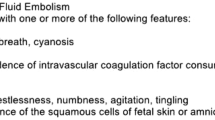Access this chapter
Tax calculation will be finalised at checkout
Purchases are for personal use only
Similar content being viewed by others
References
Fitzpatrick KE, Tuffnell D, Kurinczuk JJ, et al. Incidence, risk factors, management and outcomes of amniotic-fluid embolism: a population-based cohort and nested case-control study. BJOG. 2016;123:100–9.
Shamshirsaz AA, Clark SL. Amniotic fluid embolism. Obstet Gynecol Clin North Am. 2016;43:779–90.
Benson MD. Amniotic fluid embolism: the known and not known. Obstet Med. 2014;7:17–21.
Balinger KJ, Chu Lam MT, Hon HH, et al. Amniotic fluid embolism. Curr Opin Obstet Gynecol. 2015;27:398–405.
Clark SL, Romero R, Dildy GA, et al. Proposed diagnostic criteria for the case definition of amniotic fluid embolism in research studies. Am J Obstet Gynecol. 2016;215:408–12.
Lott C et al. European Resuscitation Council Guidelines 2021: Cardiac arrest in special circumstances, Resuscitation 2021;161:152–219
Collis RE, Collins PW. Haemostatic management of obstetric haemorrhage. Anaesthesia. 2015;70 (Suppl. 1):78–86.
Shakur H, Roberts I, Fawole B, et al (WOMAN Trial Collaborators). Effect of early tranexamic acid administration on mortality, hysterectomy, and other morbidities in women with post-partum haemorrhage (WOMAN): an international, randomised, double-blind, placebo-controlled trial. Lancet. 2017;389(10084):2105–16.
Mavrides E, Allard S, Chandraharan E, Collins P, Green L, Hunt BJ, Riris S, Thomson AJ on behalf of the Royal College of Obstetricians and Gynaecologists. Prevention and management of postpartum haemorrhage (Green-top Guideline 52). BJOG 2016;124:e106–149.
Author information
Authors and Affiliations
Corresponding author
Editor information
Editors and Affiliations
Rights and permissions
Copyright information
© 2022 Springer Nature Switzerland AG
About this chapter
Cite this chapter
Muchatuta, N., Younie, S. (2022). Amniotic Fluid Embolism. In: Fernando, R., Sultan, P., Phillips, S. (eds) Quick Hits in Obstetric Anesthesia. Springer, Cham. https://doi.org/10.1007/978-3-030-72487-0_24
Download citation
DOI: https://doi.org/10.1007/978-3-030-72487-0_24
Published:
Publisher Name: Springer, Cham
Print ISBN: 978-3-030-72486-3
Online ISBN: 978-3-030-72487-0
eBook Packages: MedicineMedicine (R0)




